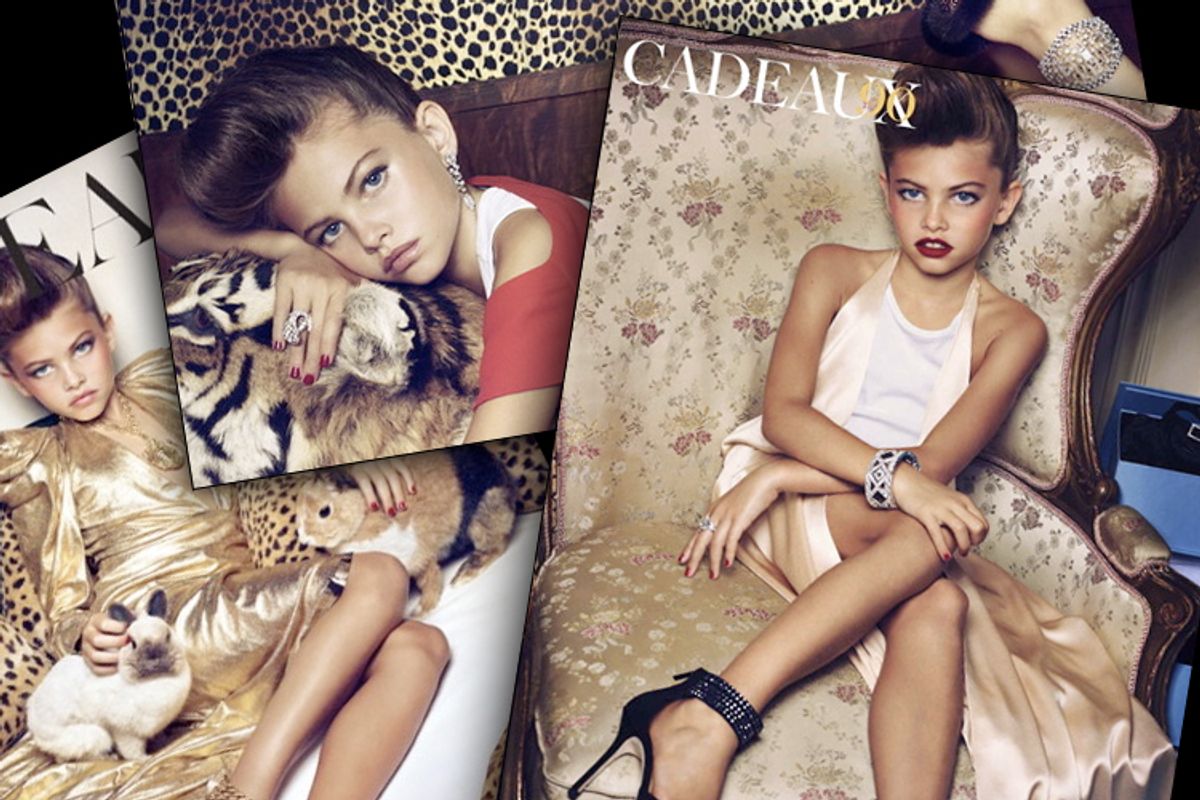I've been having déjà vu the last few days as stories of outrage have emerged over a pre-adolescent girl being tarted up in French Vogue. Didn't something very similar happen earlier this year?
Well, actually, this very story broke a whole seven months ago -- truly ancient news in today's media world -- and yet the controversy has been revivified. For no discernible reason, "Good Morning America" decided late last week to return these scandalous photos of 10-year-old Thylane Lena-Rose Blondea to the national spotlight once more. Now the images are everywhere from the Los Angeles Times to the Daily Mail, yet again. A Fox News commentator has even proclaimed that Vogue is responsible for both "stimulating pedophiles to act on their desires" and "creating pedophiles by coaxing dark, illegal desires out of men who would never have otherwise consciously felt them, let alone acted upon them." Ironically, the piece is accompanied by one of these supposed monster-creating images.
It all seems rather suspect -- both the claim that these photos can create pedophiles and the fact that the outrage and, importantly, the images themselves have reemerged over half a year after the fact. As for the first issue, I called on Fred Berlin, director of Johns Hopkins' Sexual Behavior Consultation Unit and an expert on pedophilia. "Certainly these images can be appealing to someone who had pedophilia, but the idea that they're going to create pedophilia in someone who isn't so predisposed seems highly unlikely," he said. "That's true just as pictures of attractive men might be appealing to someone who's gay, but they're not going to turn someone who's heterosexual into a gay person. There's nothing that would support the notion that this is going to create pedophilia."
As for why so many of those outraged by the photos keep dusting them off and displaying them for public consumption, he says, "Well, there are people who are understandably distressed at the sight of an automobile accident and yet as they're riding by they stop to look. Something compels them to stare at it," he says. "I think it's sort of the same thing here. Even people who object to it can't get past the emotion and perhaps dwell on the idea that they ought to be thinking about what to do about that emotion."
That is a generous interpretation. Less generous is the sort made by James R. Kincaid in Slate back in 2006 when images of JonBenet Ramsey had reemerged following the arrest of John Mark Karr:
It's the return of the repressed all over again, here before us, strutting its stuff and doing its cultural work because we so badly need it. Where else can we find forbidden material served up to us in ways we can both enjoy and disown? We have to deal with a most uncomfortable heritage: an "innocent" child who is also deeply eroticized. That's an unthinkable idea, but JonBenet is one of those stories that allows us to think it.
It's certainly an unsavory truth that even "normal" heterosexual men -- as in, those who are primarily attracted to adult women -- are also, although less so, physically aroused by images of pubescent and pre-pubescent girls, as Daniel Bergner's "The Other Side of Desire" explained. But physical arousal isn't always conscious, and even when it is, deciding to act on it is quite another thing altogether. (Just to put things in extreme perspective, women are physiologically aroused by baboon sex, but that doesn't mean they're one monkey centerfold away from bestiality.)
Maybe the truth lies somewhere in-between Kincaid's and Berlin's readings. It's possible to be mildly titillated by a sexually suggestive image of an adolescent and at the same time feel morally outraged by the existence of such an image. That's just the sort of animal we are.



Shares